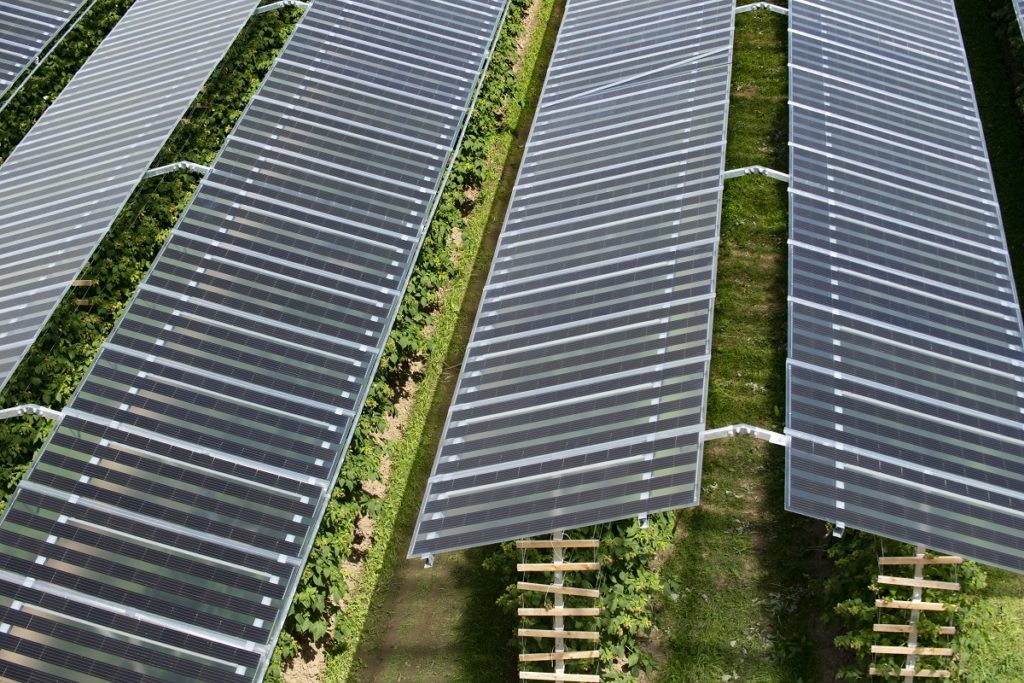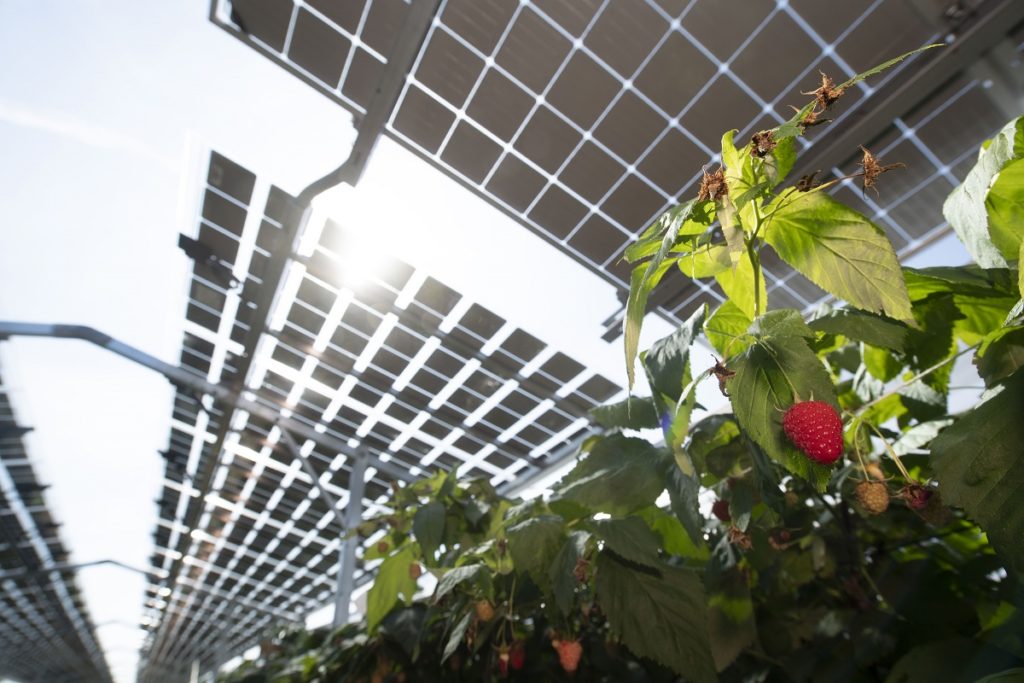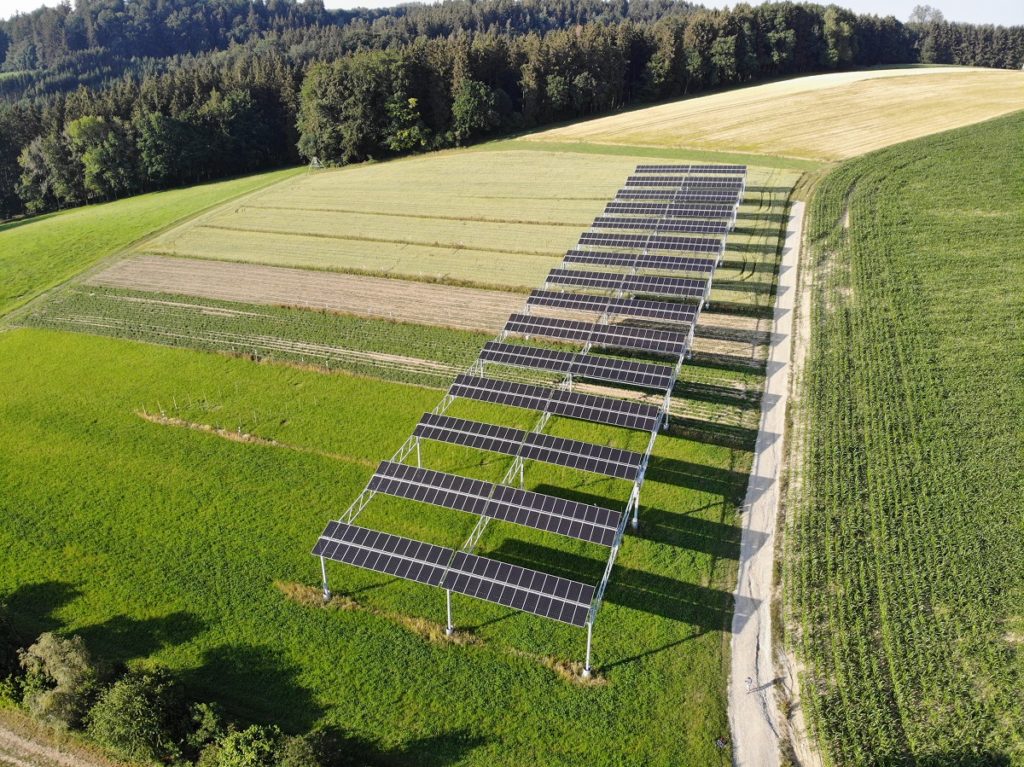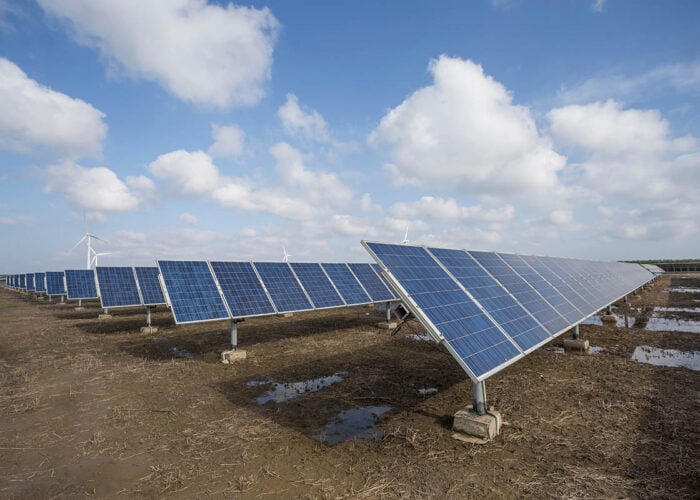
Agri-Photovoltaics (Agri-PV), where PV modules are used to optimise agricultural processes, is turning a lot of heads in the renewable energy and farming community. While in the past it was a question of either food or solar energy production on farmland, Agri-PV can combine both.
This bold application unlocks dual use of cropland by integrating PV modules above the crops, enhancing climate resilience and allowing sustainable food and energy production on one single piece of land.
Unlock unlimited access for 12 whole months of distinctive global analysis
Photovoltaics International is now included.
- Regular insight and analysis of the industry’s biggest developments
- In-depth interviews with the industry’s leading figures
- Unlimited digital access to the PV Tech Power journal catalogue
- Unlimited digital access to the Photovoltaics International journal catalogue
- Access to more than 1,000 technical papers
- Discounts on Solar Media’s portfolio of events, in-person and virtual
Today, we’re looking at how technology is adapting to accommodate fruit grown beneath the panel. What lessons can we learn from these early projects pushing production boundaries and how are they helping farmers face up to the climate challenge?
The story so far
To date BayWa r.e. has undertaken several pilot Agri-PV projects across the Netherlands and Germany, which have been helping to deepen the industry’s expertise. These projects focused on wheat, potato, celery, blueberries, red currants, raspberries, strawberries, and blackberries. Currently, BayWa r.e. is also installing an Agri-PV research facility at an apple orchard.
Two of these projects, located in Babberich and Wadenoijen in the Netherlands, have now moved on from being ‘pilots’ and are fully fledged commercial projects in their own right. The raspberry growing Babberich site is counted among the biggest and most sophisticated in Europe.
The pilot project in Heggelbach, Germany, used bifacial PV modules – using the albedo effect to increase solar power yields. While this project was a success, BayWa r.e. found it made more sense to elevate the PV modules to a higher level and substitute existing farming protection systems on cash-crops. This approach can be seen on the latest ‘fruitvoltaic’ project in Wadenoijen; this project uses 4,500 PV modules to cover 4,500 red currant plants and was installed in March 2021.
Using monocrystalline panels constructed specially for the projects, engineers were able to balance protecting berries from the elements with giving them enough light to grow. Standard PV modules obviously aren’t fit for this task, as light needs to reach the plants.
These monocrystalline modules are specially constructed to let light pass through while still absorbing energy, with different levels of transparency tested to find out what would suit each fruit variety. This optimisation process in photon management between photosynthesis and photo-electric effect is the yin and yang of Agri-PV.
Meanwhile, below the panels, the crops’ environment has been fine tuned. The pilot projects grew berries, fruits requiring notoriously precise growing conditions to come out big, sweet, and juicy. Extremes of either temperature can negatively impact the quality of the fruit, so control is crucial.
Early signs show exceptional promise. On hot days, conditions beneath the panels are around two to five degrees cooler than traditional growing methods. That brings significant benefits; less heat stress and evaporation from the soil reduces water demand.
At night, heat gets retained even better than under the plastic coverings farmers currently use to protect berries from the cold. Humidity is another factor, and the environment beneath the panels keeps it more consistent 24 hours per day.
The elements are famously fickle. Those plastic coverings often fall prey to high winds, leaving berries unprotected and prone to damage, crops risk going to waste. Too much water retained on the leaves allows fungus to grow, damaging crop yields. The thicker, more robust PV panels used in these Agri-PV trials provided excellent protection.
All this seems like a hugely promising head start. In the time since these pilots were declared successes, BayWa r.e. has been able to reflect on what a wider rollout of these sites would look like in practice.

Constructing the ideal growing environment
Adapting a fruit farm to capture solar power takes a very specific approach to constructing both the panels and the containers for the berries to grow. Materials can’t impact soil fertility and support pillars are laid out so as not to obstruct planting and harvesting.
For those growing containers, the pilot projects highlighted how much raw potential there is to integrate different subsystems which can make farmers’ lives easier.
As mentioned, too much water isn’t favourable for the sensitive berries. So, incorporating rainwater harvesting, rain gutters and water storage subsystems adds extra protection. Water is captured, treated with fertiliser and plant protection products, then recycled once it has been used to grow crops.
As well as being efficient, this could ease tensions between farmers and the water sector. With water in finite supply, suppliers do not appreciate being given large quantities of treated water from farmers and being told to make it potable again. Using and recycling rainwater cuts down that pressure.
A good harvest can also present its own challenges. Branches laden with fat, juicy berries can bend and crack under the weight of their own success. Traditionally, these branches would be supported with wires whenever farmers noticed them drooping. The subsystems underneath the Agri-PV panels incorporate these supports as standard. Farmers spend less time looking over their shoulders, micromanaging plants branch by branch.
Of course, we humans aren’t the only ones partial to these sweet berries. Insects have been the farmer’s natural nemesis for thousands of years; protecting plants means using chemicals or encasing them entirely in foil. This new environment incorporates far more effective and efficient insect protection into the mounting system.
Improved water usage, less micromanagement, and increased protection are the three standout lessons learned from the success of the pilots. The ability to tweak fine details of growing conditions also adds huge benefits.
The benefits of digital farming
Early frost warning systems interact well with environmental controls. In turn, these controls can detect when the plants are too shaded from the sun and activate LED lighting at key points throughout the day.
The interplay between these systems gives farmers minute control over the environment. The parameters of that environment can be identified as part of the farm’s water cycle. Humidity, temperature, solar radiation, soil temperature, even leaf wetness can be measured and controlled.
Algorithms work out the consequences of changes to the environment and make suggestions to farmers via a web portal and app. The entire system can then connect to weather satellites which provide the macro ‘big picture’ of each individual farm’s context. BayWa r.e. is using the products and services of NEXT Farming and thereby leveraging synergies and competence from its own parent company, BayWa AG.
Agri-PV farming has the potential to create a large amount of data which can be used to refine future projects and control growing environments down to the fine details. But farmers have to buy into these projects and see value for themselves and their customers if they’re going to change centuries of tradition. What effects do such advanced growing conditions have on the daily lives of those working with them?
Developing quality control standards in Agri-PV
BayWa r.e. has been involved in developing standardisations for Agri-PV since 2019. The aim of this work is to set out quality standards for Agri-PV systems and to ultimately reduce the technical risk for all project participants, with a particular focus on the farmer. This work has helped to support the recent launch of the German Agri-PV standard – DIN SPEC 91434 which was recently published inApril 2021. The standard, which was initially developed by the Fraunhofer Institute for Solar Energy Systems ISE and the University of Hohenheim, sets out the requirements and quality standards needed to define an Agri-PV project. The standard looks at the main agricultural uses for Agri-PV as well as elements such as the standards for planning, operation, ongoing monitoring, and documentation.
The effect of Agri-PV on traditional agriculture
When you think of farming, you envision long days in the fields manually tending to every inch of land by hand. There’s a certain romance to that idea; the notion of a farmer so in tune with his crops that he can spot and correct potential issues merely by looking at them. As with all romances though, the reality is a little grittier.
Commercial pressure on farmers in northern Europe means any help is very much appreciated. Even if we isolate the benefits we just mentioned; environment control and access to better weather forecasting, that alone carries enormous potential to assist farmers. Communicating a wider sense of value to farmers is crucial, as some farmers may be sceptical regarding the cost saving potential. Understandably, they fear both the losses in their agricultural production and higher costs of maintaining the PV installation.
But on the other hand, farmers will have lower operational and investment costs, as well as far less waste and improved quality of the fruit. Agri-PV diversifies a farmer’s income with multiple viable revenue streams and, of course, the land is performing two vital jobs instead of just one, helping farmers in addition to decarbonise their farming activities.
For a project to be viable, a contribution margin analysis needs to show positive financial returns on the agricultural products. It’s not a case of solar power propping up the crops, or vice versa. Both need to turn a profit.
The pilot projects grew berries; blueberries, strawberries and the like. Current Agri-PV technology lends itself well to crops with shorter lead wetness phases. As it matures, we’ll start to get a clearer picture which might educate crop selection.
Further pilot projects on other crops in the Netherlands and Germany are set to expand our ideas of what’s possible. Initial projects placed solar panels at a height of five metres, enough for harvesters to pass through. However, the perfect height for projects is still something that the pilot projects are trying to ascertain.
The fact that Agri-PV is such a young application of an established technology means now is the time to work closely with farmers to see what does and doesn’t work in practice. It’s important to note that farmer satisfaction was a key metric for the pilot projects.
Without the thumbs-up from those using the technology every day, none of the pilot sites could be considered a success. The fact that farmers approved so strongly of new Agri-PV methods suggests strong potential for wider uptake. However, for that to happen, we need to be having honest conversations with the farming sector about the benefits and challenges of adopting Agri-PV.

The real cost of Agri-PV technology
The nature of the elevated, transparent panels used specifically for these projects means that, on the surface, upfront costs will always be higher than ground-mounted PV modules. Cost drivers include specialist construction and installation of transparent modules and the lower power yield per area.
In Europe, the levelised cost of electricity for berry cultivation sits at around eight cents. For tree-grown fruits like apples, you might expect around nine or ten cents. Compare that to a cost of five to seven cents for ground-mounted units.
Reasons for this are fairly clear. Constructing special PV modules which actually generate less solar power then standard ones might seem like a tough sell at first. But in context, that thinking is like comparing apples to pears.
For one thing, those costs are likely to come down as the technology becomes more widely accepted and perfected. Ground-mounted PV modules have been iterated and improved over a 20-year period, Agri-PV has been in development for maybe two years. Given that the difference in levelised cost is a matter of a few cents, that’s actually very promising for Agri-PV.
It’s also short sighted to compare it only to ground-mounted PV units. Building-mounted PV has been in development for a similar amount of time, decades, and still comes with a levelised cost of between seven and 11 cents. That’s potentially even higher than the much younger Agri-PV. When compared to rooftop PV modules, the cost is roughly equal.
For the farmer, any agricultural subsidies they are currently receiving from the government remain in place. The majority of the farm will remain untouched and they simply add the benefit of the solar PV infrastructure. This is combined with lower investment, operating, and cultivation costs. Less plant production products, fewer plastic coverings and wooden supports which need to be regularly changed. It’s been estimated that introducing Agri-PV could give farmers savings of €4.0 – 6.5 per hectare per year, as well as improving the fruit’s quality.
That’s the crux of the matter. The conversation needs to focus on this new technology as a holistic thing that fits into a wider reality. Because that reality involves all sectors of society pulling together for the greater good.
The bigger picture
Climate change presents a challenge with far-reaching consequences beyond simple profit and loss. Not just in developing countries, but also in the EU, we’re already seeing serious degradation of formerly arable land. As land starts to become scarcer, the nexus of food, energy, and water demands options like Agri-PV.
Extreme weather is set to become more common, requiring greater crop protection. Excess solar radiation calls for new farming solutions. Water needs to be preserved and handled more efficiently. Densely populated areas require solutions to ease the competition for land. These hurdles can be overcome by a wider adoption of Agri-PV, but political leadership is needed to bring all the players in line and bridge the gap between different elements.
One example sums up the situation perfectly; customers in supermarkets are being encouraged to use less plastic. In some cases, plastic packaging has been banned from stores altogether. Meanwhile, on the farms producing the fruits sold in those supermarkets, farmers are still employing single-use plastic on an industrial scale. Plastic sheets used to protect crops are damaged by high winds and replaced every few months. Solutions like Agri-PV bridge the gap between legislation, production, and the reality of what consumers want.
All this can be done quickly and at scale. In Germany alone, the amount of land used for compatible crops is around 1% but that’s still over 70,000 hectares. Having all that land performing two tasks at once completely changes the equation of how we approach sustainability.
As the technology matures and becomes viable with more and more crops, those environmental pull factors will grow exponentially. Agri-PV isn’t the only solution to the climate challenges facing the world, but it’s one potential option with enormous levels of synergy. It lets farming interact with other sectors more productively and plug into the solutions employed by those sectors to answer their own climate questions.
Right now, Agri-PV shows huge potential, both in terms of the technology being used and the spaces in which it can be applied. Engineers can tackle interesting technical challenges, helping develop a young technology with huge room for growth. Investors can bet on proven solutions with clear applications, politicians can demonstrate that they have the answers to big challenges.
But central to all that are the farmers whose land will form the backbone of this new approach to clean energy and agriculture. Anyone with a technical, commercial, or political interest in Agri-PV needs to spend serious time listening to those who make their living from the land.
Engaging with the agricultural sector, BayWa r.e. is building a compelling case, which is no surprise. Born from agritech giants, BayWa AG, farming is in their DNA. With the early success of its pilot projects, it prepared a body of data which offsets cost against value, demonstrating how much sheer scope these methods have to grow.
Ultimately, addressing climate change isn’t an exercise in navel-gazing. The time is now to get this evidence in front of the right people so they can act on it. Agri-PV is only one piece of the climate puzzle, but working together with other innovators in other sectors, it could prove invaluable. The sooner those connections are made, the better.
Author
Stephan Schindele, head of product management Agri-PV, BayWa r.e. Solar Projects
An internship in a solar association in 2009 was the starting point of his professional career in the field of renewable energies. During his studies Stephan Schindele worked several times for the United Nations Framework Convention on Climate Change (UNFCCC). After completing his MBA program at the California State University East Bay (2011) he was employed as a PhD candidate and project manager at the Fraunhofer Institute for Solar Energy Systems ISE. There he built up the new business field of agri-photovoltaics, wrote numerous publications on the topic of Agri-PV and received several awards for his work (2012-2020). Between 2015 and 2020 he taught energy policy at Reutlingen University. In 2020 Stephan Schindele joined the BayWa r.e. Solar Projects family as Head of Agri-PV. He supports the global Agri-PV market development and successfully leverages the synergies of the agricultural and energy industry.







